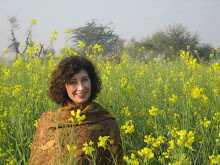
I was waiting at the airport in Delhi for some friends. The flight was late, the wait was long. I sat on a staircase where I could observe the crowd from above. I started focusing on the sea of turbans below, one of the distinctive items of dress in India. Here in the airport I noted an amazing array of colors. I saw turbans in gold, magenta, salmon, lilac, tan, cream, peach, seafoam, burgundy, rust, orange, sage, wine, forest greet, black, navy, gray, white, periwinkle, butter yellow, peridot, cornflower blue, and chartreuse.
Solid colored or print, giant, small, tall, simply or elaborately wrapped, turbans are an important part of the culture in Rajasthan worn by men throughout the state. There is a tremendous amount of variation, depending on familial affiliation, religion, region, season, occupation, and occasion. The fabric is typically a pure soft cotton dyed in a variety of colorful shades. The length of the cloth varies but is typically between 20 and 36 feet long and. 9 to 12 inches wide. Male members of the Sikh religion always wear a turban, keeping their long, uncut hair from view.
In India visitors will find constant visual displays of incongruity when tradition meets "progress" and ancient meets modern. During initial visits I always did a double-take when I saw turbaned men in the countryside riding motor scooters. It seems so, well, incongruous. Now it seems perfectly normal.
An interesting albeit slightly dusty turban museum can be found at Surabhi's restaurant in Jaipur. It's a wonderful, pillared heritage property on Old Amer Road, with good quality food and a welcoming atmosphere. The owner has amassed quite a collection of Rajasthani headgear with detailed descriptions about each style.
If you're predisposed to purchasing a turban but are intimidated by tying it, don't despair. There are ready-to-wear turbans available for different head sizes. Go on, try one on for size.
Solid colored or print, giant, small, tall, simply or elaborately wrapped, turbans are an important part of the culture in Rajasthan worn by men throughout the state. There is a tremendous amount of variation, depending on familial affiliation, religion, region, season, occupation, and occasion. The fabric is typically a pure soft cotton dyed in a variety of colorful shades. The length of the cloth varies but is typically between 20 and 36 feet long and. 9 to 12 inches wide. Male members of the Sikh religion always wear a turban, keeping their long, uncut hair from view.
In India visitors will find constant visual displays of incongruity when tradition meets "progress" and ancient meets modern. During initial visits I always did a double-take when I saw turbaned men in the countryside riding motor scooters. It seems so, well, incongruous. Now it seems perfectly normal.
An interesting albeit slightly dusty turban museum can be found at Surabhi's restaurant in Jaipur. It's a wonderful, pillared heritage property on Old Amer Road, with good quality food and a welcoming atmosphere. The owner has amassed quite a collection of Rajasthani headgear with detailed descriptions about each style.
If you're predisposed to purchasing a turban but are intimidated by tying it, don't despair. There are ready-to-wear turbans available for different head sizes. Go on, try one on for size.



nice post about turbans ,Our SEO Training Institute in jaipur gives the training of Search Engine Optimization by Professional instructor to make students experts in seo promotion . Our classes based on 100% practical which develop real time SEO and SMO professionals.We are bestSEO training institute in Jaipur who also provide best seo service in Jaipur
ReplyDeleteJaipur metro map
rajasthan tourism places
Jaipur in Rajasthan
lake city udaipur tourism places
jodhpur tourism places
bikaner tour
Jaisalmer desert festival
about rajasthan
MOUNT ABU tourism places in Rajasthan
shekhawati festival
city palace in Jaipur
jantar mantar in Jaipur
albert hall museum in Jaipur
moti dungri ganeshji temple in Jaipur
hawamahal in Jaipur
Jai garh fort Jaipur
nahargarh fort in Jaipur
amber palace in Jaipur
albert hall museum in Jaipur
city palace in Jaipur
govind dev ji Temple in Jaipur
birla temple in Jaipur
bussiness opportunities in Jaipur
Achalgarh fort,Mount Abu
nice information about turbans are shared here know about our Sunrise Health Resorts in Jaipur and water park in Jaipur, Have developed a special 7 days programme called Anti-Ageing, based on Ayurveda centre in Jaipur & ayurveda hospital in Jaipur,ayurveda treatment in Jaipur, Yoga centre in Jaipur and Naturopathy treatment in Jaipur; these ancient systems of wellness centre in Jaipur. contact-9828590094
ReplyDeleteall rajasthan
seo training institute in Jaipur
seo service in Jaipur
spa in Jaipur
spa centre in Jaipur
rajasthan government jobs
water park in Jaipur
Panchakarma treatment in Jaipur
Shirodhara treatment in jaipur